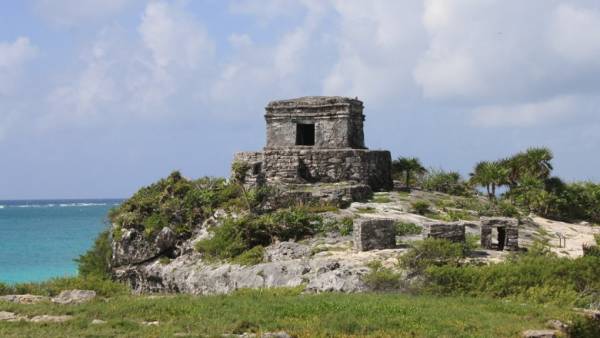Purely environmental murder. The five civilizations that died by his fault
MOSCOW, 29 Sep — RIA Novosti, Alfia Enikeeva. Empires collapse not only from the barbarian invasions or civil wars for power. According to a number of studies, some developed ancient societies have disappeared from the face of the Earth due to environmental problems — air pollution, deforestation and soil erosion.
Nevertheless bronze age
An international team of scientists examined hundreds of fossil bones of animals found in Ireland, and came to the conclusion that the biogeochemical cycles in the soil (including nitrogen) was broken in the bronze age about three thousand years ago.
The excess in the bones of the isotopes of nitrogen 15N indicates interference in the natural ecosystems of the person. At the end of the middle bronze age the content of this substance in the soil is dramatically increased and never dropped to the original values.
In the wild, the nitrogen accumulates in the soil and is excreted out continuously, providing a balance.
Ancient tillers, cutting down forests, sowing areas of cultivated plants and breeding livestock, broke this delicate balance and completely changed the ecosystem of the soil of Ireland.
According to the authors, the results of the study can be extended to other regions of the world. It turns out that to change the nature of the man was several centuries earlier than previously thought.
Carved wood Mayan
It is the disruption of biochemical cycles and, as a consequence, the depletion of soils have contributed to the disappearance of the Mayan civilization, sure American and canadian geologists. Analysis of organic sediments from the bottom of lakes Chichancanab, Salpeter and Itcan in southern Mexico showed that the conversion of Mayan villages in the first major city-state was accompanied by intensive felling of tropical forests for arable land and, consequently, degradation of the soil.

Deforested soil was destroyed, they were washed micronutrients. These permanent changes made Mayan land infertile, which resulted in famine and political instability. In the IX century ad, the people left most of the city-States of the Maya.
Idols instead of animals
Similar thing happened on Easter island.
Due to massive deforestation began wind and rain erosion, which is evident by the increase in the amount leached out of soil metal ions in sediments.
The consequences were immediate: the dried raw materials — the forest of wild edible plants, fell the productivity of cultivated cereals. Land birds disappeared completely, and species diversity of seabirds declined by nearly three times. Lack of resources led to war between the tribes, increasing social inequality, the emergence of the famous stone moai statues and the mass extinction of the population.

Soil investigation and foundations of the buildings remaining on the island, have demonstrated that, when it was inhabited by the people, the land was barren desert, there was subtropical forest with high trees and bushes. The forest was cut down, probably about the year 900 of our era. By the XX century, the island had only 48 species of plants, the largest of which, toromiro, not higher than two meters. The rest is low ferns, grasses, sedges and shrubs.
As noted by the evolutionary biologist Jared diamond in his book “Collapse. Why some companies lead to prosperity and others to destruction”, the islanders were not foreign enemies, because they were isolated and almost no one was contacted. No evidence about climate change during this period either. The disappearance of the culture of the moai — the purely ecological accident in which the guilty inhabitants of Easter island.
The destruction of green island
The Vikings colonized in the tenth century, Greenland, unwisely consumed natural resources and thereby hastened the destruction of their community. For a long time it was believed that the descendants of Eric the Red left the island due to climate change. When in the year 986 the Vikings landed in Greenland, average annual temperatures in Europe were quite high. Four centuries later came the so-called little ice age that triggered the famine and the mass death of the population.

However, the analysis of samples of the Greenland glacier, held in 2015, the American scientists has led to the conclusion that there is no warming in X—XIII centuries in those places was not observed. In the tenth century there was as cold as in the fourteenth, when the last of the Vikings left the island. So the theory of abrupt climate change is unlikely to correspond to reality.
According to Jared diamond, the warlike Scandinavians suffered in Greenland failed because of a combination of several factors, but mostly due to consumer attitude to natural resources.
Research lake sediments have shown that the Vikings burned down forests for grazing cattle, cut turf for building and heating.
Soil, devoid of vegetation, were destroyed. The Norse population of Greenland disappeared completely thousands, exhausted by hunger, died in wars and riots, thousands left, and of the descendants of Erik the Red’s nobody left.
Everything can be fixed
Described environmental problems fatal to civilization, only if the population does not want to adapt to changing conditions. The Vikings Dimon opposes the Inuit who lived in Greenland at the same time. The houses they built of snow and ice, warmed subcutaneous fat seals, and ate mostly fish and sea animals.
According to zooarchaeologist, the ancient Egyptians contributed to the fact that in the Nile valley disappeared, the wild beasts, but managed to adapt by increasing in proportion of diet of cultivated cereals. As found by researchers from the University of California at Santa Cruz, University of Sao Paulo and Bristol, for the last four thousand years, from 37 large mammals that lived in Ancient Egypt to the present day survived only seven.
Scientists emphasize that now the ecological situation in the Nile valley especially fragile and break very easy. The loss of one or two species could trigger a new ecological disaster.